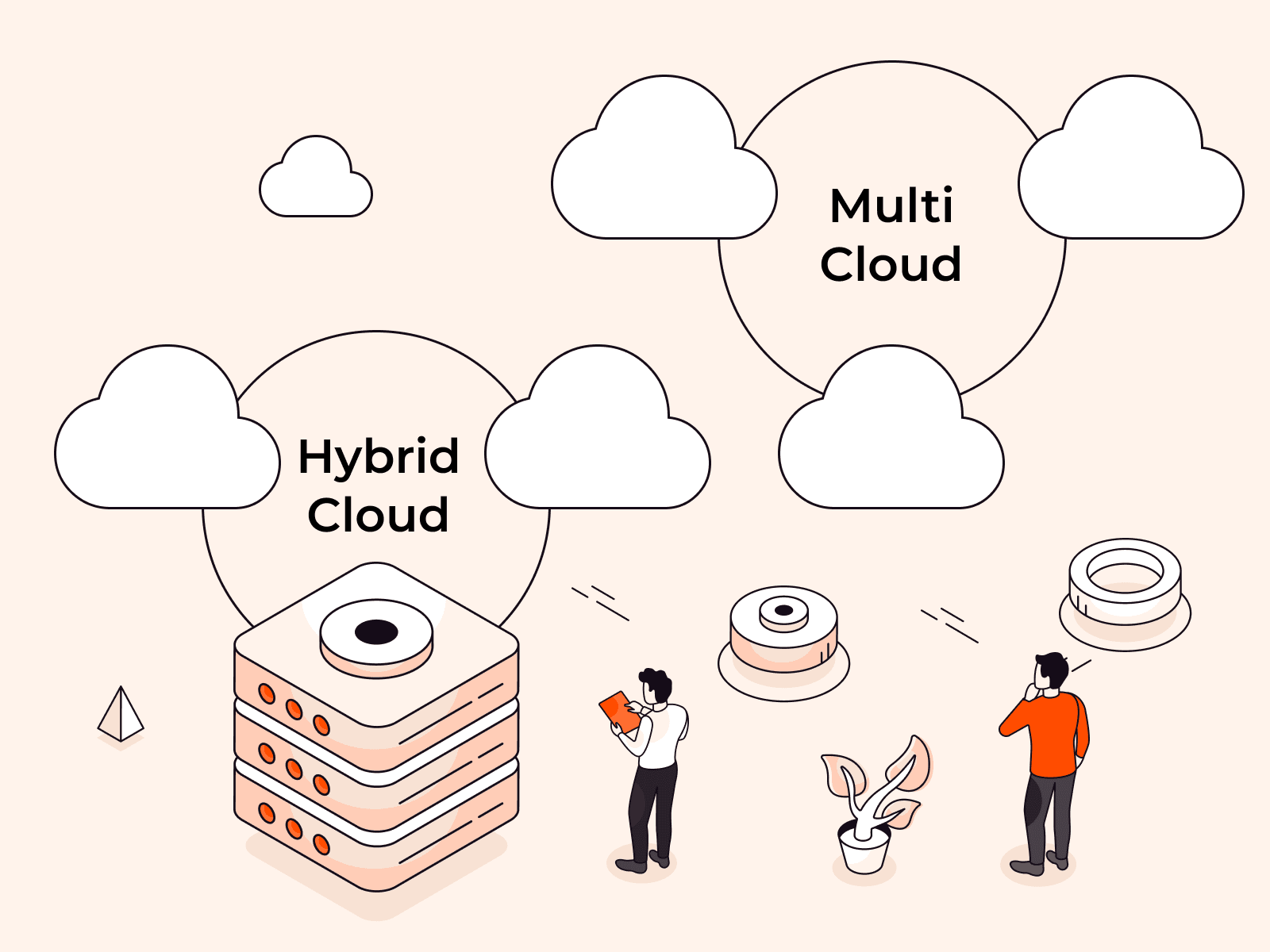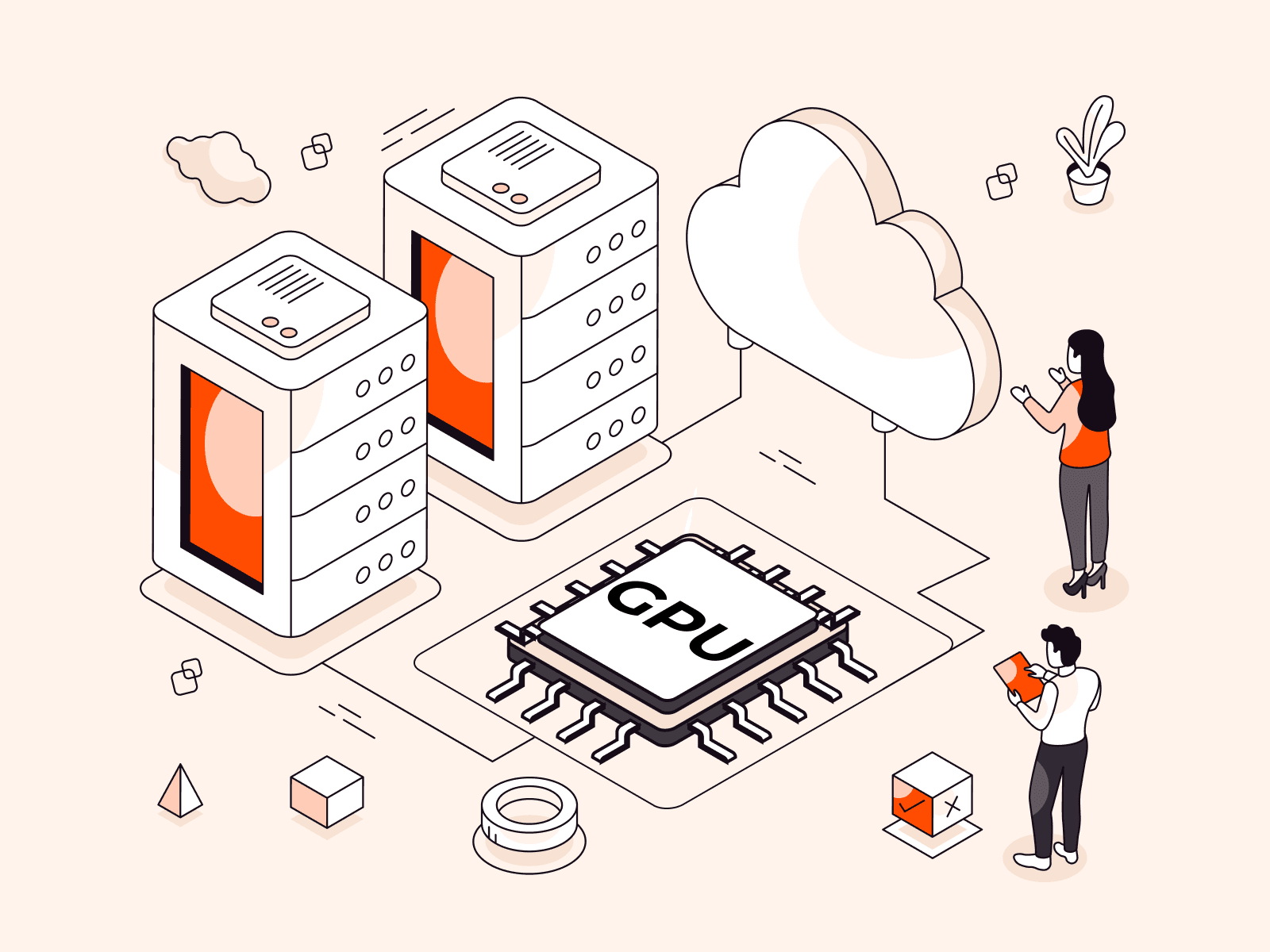A private cloud is a cloud computing environment dedicated exclusively to a single organization, providing a single-tenant infrastructure that improves security, control, and customization compared to public clouds.
Private cloud environments can be deployed in two primary models based on location and management approach. Organizations can host private clouds on-premises within their own data centers, maintaining direct control over hardware and infrastructure, or outsource to third-party providers through hosted and managed private cloud services that deliver dedicated resources without the burden of physical maintenance.
The technical foundation of private clouds relies on several core architectural components working together to create isolated, flexible environments.
These include virtualization technologies such as hypervisors and container platforms, software-defined networking that enables flexible network management, software-defined storage systems, cloud management platforms for orchestration, and advanced security protocols that protect sensitive data and applications.
Private cloud adoption delivers measurable business value through improved operational effectiveness and cost control. Well-managed private cloud environments can reduce IT operational costs by up to 30% compared to traditional on-premises infrastructure while achieving average uptime rates exceeding 99.9%, making them attractive for organizations with strict performance and reliability requirements.
Understanding private cloud architecture and use becomes essential as organizations seek to balance the benefits of cloud computing with the need for enhanced security, regulatory compliance, and direct control over their IT infrastructure.
What is a private cloud?
A private cloud is a cloud computing environment dedicated exclusively to a single organization, providing complete control over infrastructure, data, and security policies. This single-tenant model means all computing resources, servers, storage, and networking serve only one organization, unlike public clouds, where resources are shared among multiple users. Private clouds can be hosted on-premises within an organization's own data center or managed by third-party providers while maintaining the exclusive access model.
This approach offers enhanced security, customization capabilities, and regulatory compliance control that many enterprises require for sensitive workloads.
The foundation of private cloud architecture relies on virtualization technologies and software-defined infrastructure to create flexible environments. Hypervisors like VMware ESXi. Microsoft Hyper-V, and KVM enable multiple virtual machines to run on physical servers, while container platforms such as Docker and Kubernetes provide lightweight application isolation. Software-defined networking (SDN) allows flexible network management and security micro-segmentation, while software-defined storage (SDS) pools storage resources for effective allocation.
Cloud management platforms like OpenStack. VMware vRealize, and Nutanix organize these components, providing automated provisioning, self-service portals, and policy management that simplify operations.
Private clouds excel in scenarios requiring strict security, compliance, or performance requirements. Financial institutions use private clouds to maintain complete control over sensitive customer data while meeting regulations like GDPR and PCI DSS. Healthcare organizations use private clouds to securely process patient records while ensuring HIPAA compliance.
Government agencies use private clouds with advanced security controls and network isolation to protect classified information. Manufacturing companies use private clouds to safeguard intellectual property and maintain operational control over critical systems.
The operational benefits of private clouds include improved resource control, predictable performance, and customizable security policies. Organizations can configure hardware specifications, security protocols, and compliance measures to meet specific requirements without the constraints of shared public cloud environments.
Private clouds also enable better cost predictability for consistent workloads, as organizations aren't subject to variable pricing based on demand fluctuations. Resource provisioning times in well-managed private clouds typically occur within minutes, providing the agility benefits of cloud computing while maintaining complete environmental control.
How does a private cloud work?
A private cloud works by creating a dedicated computing environment that serves only one organization, using virtualized resources managed through software-defined infrastructure. The system pools physical servers, storage, and networking equipment into shared resources that can be flexibly allocated to different applications and users within the organization.
The core mechanism relies on virtualization technology, where hypervisors like VMware ESXi or Microsoft Hyper-V create multiple virtual machines from physical hardware. These virtual environments run independently while sharing the same underlying infrastructure, allowing for better resource use and isolation.
Container platforms, such as Docker and Kubernetes, provide an additional layer of virtualization for applications.
Software-defined networking (SDN) controls how data flows through the private cloud, creating virtual networks that can be configured and modified through software rather than physical hardware changes. This allows IT teams to set up secure network segments, manage traffic, and apply security policies flexibly. Software-defined storage (SDS) works similarly, abstracting storage resources so they can be managed and allocated as needed.
Cloud management platforms serve as the control center, providing self-service portals where users can request resources, automated provisioning systems that use new services quickly, and monitoring tools that track performance and usage.
These platforms handle the orchestration of all components, ensuring resources are available when needed and properly secured in accordance with organizational policies.
What are the benefits of a private cloud?
The benefits of a private cloud refer to the advantages organizations gain from using dedicated, single-tenant cloud computing environments. The benefits of a private cloud are listed below.
- Enhanced security control: Private clouds provide isolated environments where organizations maintain complete control over security policies and access controls. This single-tenant architecture reduces exposure to external threats and allows for custom security configurations tailored to specific compliance requirements.
- Improved data governance: Organizations can use strict data residency and handling policies since they control where data is stored and processed. This level of control is essential for industries such as healthcare and finance that must comply with regulations such as HIPAA or PCI DSS.
- Customizable infrastructure: Private clouds allow organizations to tailor hardware, software, and network configurations to meet specific performance and operational requirements. This flexibility enables optimization for unique workloads that might not perform well in standardized public cloud environments.
- Predictable performance: Dedicated resources eliminate the "noisy neighbor" effect common in shared environments, providing consistent performance for critical applications. Organizations can guarantee specific performance levels and resource availability for their most important workloads.
- Cost predictability: While initial setup costs may be higher, private clouds offer more predictable ongoing expenses compared to usage-based public cloud pricing. Organizations can better forecast IT budgets and avoid unexpected charges from traffic spikes or resource overuse.
- Regulatory compliance: Private clouds make it easier to meet strict industry regulations by providing complete visibility and control over data handling processes. Organizations can use specific compliance frameworks and undergo audits more easily when they control the entire infrastructure stack.
- Reduced latency: On-premises private clouds can provide faster response times for applications that require low latency, as data doesn't need to travel to external data centers. This proximity benefit is particularly valuable for real-time applications and high-frequency trading systems.
What are common private cloud use cases?
Common private cloud use cases refer to specific business scenarios and applications where organizations use dedicated, single-tenant cloud environments to meet their operational needs. These use cases are listed below.
- Regulatory compliance: Organizations in heavily regulated industries use private clouds to meet strict data governance requirements. Financial institutions utilize private clouds to comply with regulations such as SOX and Basel III, while healthcare providers ensure HIPAA compliance to protect patient data.
- Sensitive data protection: Companies handling confidential information choose private clouds for enhanced security controls and data isolation. Government agencies and defense contractors use private clouds to protect classified information and maintain complete control over data access and storage locations.
- Legacy application modernization: Businesses modernize outdated systems by migrating them to private cloud environments while maintaining existing integrations. This approach enables organizations to reap the benefits of the cloud, such as flexibility and automation, without having to completely rebuild their critical applications.
- Disaster recovery and backup: Private clouds serve as secure backup environments for business-critical data and applications. Organizations can replicate their production environments in private clouds to ensure rapid recovery times and reduce downtime during outages.
- Development and testing environments: IT teams use private clouds to create isolated development and testing spaces that mirror production systems. This setup enables faster application development cycles while maintaining security boundaries between different project environments.
- High-performance computing: Research institutions and engineering firms use private clouds to handle computationally intensive workloads. These environments provide dedicated resources for tasks like scientific modeling, financial analysis, and complex simulations without resource contention.
- Hybrid cloud combination: Organizations use private clouds as secure foundations for hybrid cloud strategies, connecting internal systems with public cloud services. This approach allows companies to keep sensitive workloads private while using public clouds for less critical applications.
What are the challenges of private cloud implementation?
Challenges of private cloud use refer to the technical, financial, and operational obstacles organizations face when using dedicated cloud infrastructure. The challenges of private cloud use are listed below.
- High upfront costs: Private cloud deployments require significant initial investment in hardware, software licenses, and infrastructure setup. Organizations typically spend 40-60% more in the first year compared to public cloud alternatives.
- Complex technical expertise requirements: Managing private clouds demands specialized skills in virtualization, software-defined networking, and cloud orchestration platforms. Many organizations struggle to find qualified staff with experience in technologies like OpenStack, VMware vSphere, or Kubernetes.
- Resource planning difficulties: Determining the right amount of compute, storage, and network capacity proves challenging without historical usage data. Over-provisioning leads to wasted resources, while under-provisioning causes performance issues and user frustration.
- Integration with existing systems: Legacy applications and infrastructure often don't work smoothly with modern private cloud platforms. Organizations must invest time and money in application modernization or complex integration solutions to ensure seamless operations.
- Ongoing maintenance overhead: Private clouds require continuous monitoring, security updates, and performance optimization. IT teams spend 30-40% of their time on routine maintenance tasks that cloud providers handle automatically in public cloud environments.
- Flexibility limitations: Physical hardware constraints limit how quickly organizations can expand their private cloud capacity. Adding new resources often takes weeks or months, compared to the instant growth available in public clouds.
- Security and compliance complexity: While private clouds offer better control, organizations must design and maintain their own security frameworks to ensure optimal security and compliance. Meeting regulatory requirements, such as GDPR or HIPAA, becomes the organization's full responsibility rather than being shared with a provider.
How to develop a private cloud strategy
You develop a private cloud plan by assessing your organization's requirements, choosing the right use model, and creating a detailed use roadmap that aligns with your business goals and technical needs.
First, conduct a complete assessment of your current IT infrastructure, workloads, and business requirements. Document your data sensitivity levels, compliance needs, performance requirements, and existing hardware capacity to understand what you're working with today.
Next, define your security and compliance requirements based on your industry regulations. Identify specific standards, such as HIPAA for healthcare, PCI DSS for payment processing, or GDPR for European data handling, that will influence your private cloud design.
Then, choose your model from on-premises, hosted, or managed private cloud options. On-premises solutions offer maximum control but require a significant capital investment, while hosted solutions reduce infrastructure costs but may limit customization options.
Next, select your core technology stack, which includes virtualization platforms, software-defined networking solutions, and cloud management tools. Consider technologies such as VMware vSphere, Microsoft Hyper-V, or open-source options like OpenStack, based on your team's expertise and budget constraints.
Create a detailed migration plan that prioritizes workloads based on business criticality and technical complexity. Start with less critical applications to test your processes before moving mission-critical systems to the private cloud environment.
Establish governance policies for resource allocation, access controls, and cost management. Define who can provision resources, set spending limits, and create approval workflows to prevent cloud sprawl and maintain security standards.
Finally, develop a monitoring and optimization plan that includes performance metrics, capacity planning, and regular security audits. Set up automated alerts for resource use, security incidents, and system performance to maintain best operations.
Start with a pilot project involving 2-3 non-critical applications to validate your plan and refine processes before growing to your entire infrastructure.
Gcore private cloud solutions
When building a private cloud infrastructure, the foundation you choose determines your long-term success in achieving the security, performance, and compliance benefits these environments promise. Gcore's private cloud solutions address the core challenges organizations face with dedicated infrastructure that combines enterprise-grade security with the flexibility needed for flexible workloads. Our platform delivers the 99.9%+ uptime reliability that well-managed private clouds require, while our global infrastructure, with over 210 points of presence, ensures consistent 30ms latency performance across all your locations.
What sets our approach apart is the elimination of common private cloud use barriers—from complex setup processes to unpredictable growing costs, while maintaining the single-tenant isolation and customizable security controls that make private clouds attractive for regulated industries. Our managed private cloud options provide the dedicated resources and compliance capabilities you need without the overhead of building and maintaining the infrastructure yourself.
Discover how Gcore private cloud solutions can provide the secure, flexible foundation your organization needs.
Frequently asked questions
Is private cloud more secure than public cloud?
No, a private cloud isn't inherently more secure than a public cloud - security depends on use, management, and specific use cases, rather than the use model alone. Private clouds offer enhanced control over security configurations, dedicated infrastructure that eliminates multi-tenant risks, and customizable compliance frameworks that can reduce security incidents by up to 40% in well-managed environments. However, public clouds benefit from enterprise-grade security teams, automatic updates, and massive security investments that many organizations can't match internally.
How does private cloud differ from on-premises infrastructure?
Private cloud differs from on-premises infrastructure by providing cloud-native services and self-service capabilities through virtualization and software-defined management, while on-premises infrastructure typically uses dedicated physical servers without cloud orchestration. On-premises infrastructure relies on fixed hardware allocations, whereas private cloud pools resources flexibly and offers automated provisioning through cloud management platforms.
What happens to my data if I switch private cloud providers?
Your data remains yours and can be migrated to a new provider, though the process requires careful planning and may involve temporary service disruptions. Most private cloud providers offer data portability tools and migration assistance, but you'll need to account for differences in storage formats, security protocols, and API structures between platforms.
Related articles
Subscribe to our newsletter
Get the latest industry trends, exclusive insights, and Gcore updates delivered straight to your inbox.






